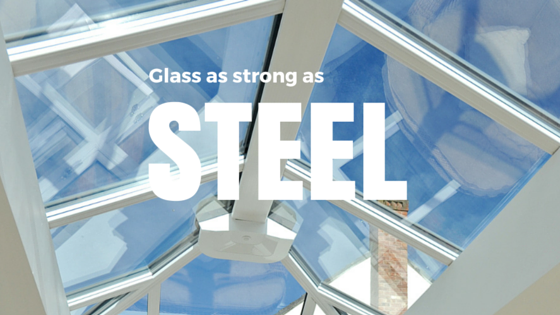Imagine a window with glass that is about as strong as steel, yet is thin and light. Thanks to Japanese researchers this has come one big step closer.
Young’s Modulus
Here is an article from tech website Gizmodo that explains the development:
Scientists in Japan say they’ve fashioned glass that’s almost as strong as steel.
The ability to make super strong glass could lead to a whole new generation of windows in buildings and vehicles, but could also prove useful in screens for electronics, like tablets, computers, and smartphones. The team, from the University of Tokyo’s Institute of Industrial Science, had their findings published earlier this month in Scientific Reports by Nature.
“We are looking to commercialize the technique within five years,” University of Tokyo assistant professor Atsunobu Masuno told Asahi Shimbun.
Here’s the secret ingredient in such tough glass: alumina. It’s an oxide of aluminum, and mixing it with silicon dioxide makes glass way tougher. Problem is, when scientists have tried to use large amounts of alumina in the past, it caused the mixture to crystallize as soon as it touched any kind of container, preventing glass from being formed.
So the Tokyo team brewed up a method of making glass that required no container at all: they used gas to push the chemical components into the air, where they synthesized together. The result? A transparent ultra glass that’s 50% alumina and rivals the Young’s modulus of steel and iron, which measures rigidity and elasticity in solids.
The practical uses are broad, since the study notes that alumina glass made via aerodynamic levitation can yield a product that’s thin, light, and has excellent optical properties. We say, bring on commercialization.
[University of Tokyo and Nature via Asahi Shimbun]So that should explain some of the science behind it. Don’t know about you, but this is rather exciting.
The commercial applications for this product could be massive, and for our sector especially. Previously, when new glass technologies have been discovered, either time or commercial applications have been limited. This time it looks like it could be different.
The post above is giving a rough lead time to market of around five years. For a new discovery that isn’t as long as you’d think. Think about what it could be used for. If it is as strong as they say, it might be able to replace toughened glass and laminated glass. Depends on the cost of course.
It’s not yet known how efficient this glass can become. The glass nerds will now be itching to get hold of any technical data with the aim to see how low U-Values could go with this. But on strength alone this is one very large step forward. Perhaps this could even become the minimum standard for glass? Again, depends on the cost of production.
All technologies
This sort of innovations will have ramifications way beyond windows and doors. Going on what was mentioned in the Gizmodo post, this new glass product has applications all over the place. Literally anything with glass could be replaced with this alumina-based product.
Phones, tablets, laptop screens, TV screens, mirrors, tables, glasses (both specs and drinking tools) the list goes on. Lightweight, crystal clear, excellent optical properties. All things which makes this new glass a fantastic new material to read DGB on!
Keep an eye out on this one, it could be a game changer.
To get daily updates from DGB sent to your inbox, enter your email address in the space below to subscribe:
[wysija_form id=”1″]






Sounds dramatic but commercial reality would be decades if at all. Metallic glass inventions have been announced before and not moved into much commercialism beyond small high value tech items. If they can’t make float glass profitably as the majors constantly claim, what chance does adding high cost RMs like that have. Just research fluff for funding if you ask me!
Flat glass production technology is not a field of every year invention, even not every decade invention. We have in general one technology for a century – 19th – drawn glass, 20th – float glass, maybe 21rst century is for this invention. It’s worth to be followed how this technology moves to mass production. Cause it’s a question of huge number of inventions to convert laboratory method to mass production with all necessary technical equipment. But in general – sounds great!
Hi Mariana
Thanks for your comment. You could be right, with the 21st century being the one where glass strength and application is the new age for glass technology. I really hope this becomes a mass produced product as it could have so many applications in day to day life for so many products!
DGB